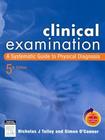临床检查
2005-12
Elsevier Science Health Science div
Talley, Nicholas J.
431
The new 5th edition of Clinical Examination continues to serve all medical students with a clear and understandable explanation of clinical examination. Set out logically and systematically, this best-selling textbook has comprehensive coverage of essential skills necessary for history taking and examining the patient. Highly regarded by students world-wide, this text continues to grow in strength. Clinical Examination, 5th edition has been revised and updated to include: more evidence-based medicine; new full-color artwork; and a fresh new look allowing greater accessibility for readers. The new edition covers clinical examination and concepts in a systems approach in a clear, consistent and user-friendly approach. Readers using this edition of Clinical Examination will have access to www.studentconsult.com. Here you will receive full online access to the text and numerous interactive extras such as video clips demonstrating some of the more difficult examinations & MCQ's. Written by two internationally renowned authors, Clinical Examination, 5th edition will continue to provide students with a superb reference for performing clinical methods. Offers access to the full text and other valuable features online via the STUDENT CONSULT website. Now in full-color. New artwork provides consistency and improves quality of images as seen in previous edition. New design of overall layout offering greater accessibility. More evidence-based medicine.
Foreword 1Foreword 2PrefaceAcknowledgmentsClinical methods: a historical perspectiveThe Hippocratic oath Chapter 1 The general principles of history taking Bedside manner and establishing rapport Obtaining the history Introductory questions The presenting (principal) symptom History of the presenting illness Current symptoms; current treatment and drug history; sexual history; menstrual history; the impact of the illness The past history The social and personal history Occupation and education; social habits and maintenance of good health; overseas travel and immunisation; marital status, social support and living conditions Activities of daily living The family history Systems review The 'uncooperative' or 'difficult' patient Cross-cultural history taking Skills in history taking The assessment References Suggested readingChapter 2 The general principles of physical examination Evidence-based clinical examination First impressions Vital signs Facies Jaundice; cyanosis; pallor; hair Weight, body habitus and posture Hydration The hands and nails Temperature Smell Preparing the patient for examination References Suggested readingChapter 3 The cardiovascular system The cardiovascular history Presenting symptoms; risk factors for coronary disease; treatment; past history; social history The cardiovascular examination Positioning the patient; general appearance; hands; arterial pulse; blood pressure; face; neck; praecordium; back; abdomen, lower limbs; peripheral vascular disease; acute arterial occlusion; deep venous thrombosis; varicose veins Correlation of physical signs and cardiovascular disease Cardiac failure; chest pain; pericardial disease; systemic hypertension; pulmonary hypertension; valve diseases of the left heart; valve diseases of the right heart; cardiomyopathy; aortic dissection; acyanotic congenital heart disease; cyanotic congenital heart disease; 'grown-up' congenital heart disease The chest X-ray: a systematic approach Frontal film; lateral film; examples of chest X-rays in cardiac disease Summary The cardiovascular examination: a suggested method References Suggested readingChapter 4 The respiratory system and breast examination The respiratory history Presenting symptoms; treatment; past history; occupational history; social history; family history The respiratory examination Positioning the patient; general appearance; hands; face; trachea; chest; heart; abdomen; other; bedside assessment of lung function Correlation of physical signs and respiratory disease Consolidation (lobar pneumonia); collapse; pleural effusion; pneumothorax; tension pneumothorax; bronchiectasis; bronchial asthma; chronic obstructive pulmonary disease (chronic airflow limitation); emphysema; chronic bronchitis; pulmonary fibrosis; tuberculosis; mediastinal compression; carcinoma of the lung; sarcoidosis; pulmonary embolism The chest X-ray Chest X-ray checklist Examination of the breasts Inspection; palpation; evaluation of a breast lump Summary The respiratory examination: a suggested method References Suggested readingChapter 5 The gastrointestinal system The gastrointestinal history Presenting symptoms; treatment; past history; social history; family history The gastrointestinal examination Positioning the patient; general appearance; the hands; the arms; the face; the neck and chest; the abdomen--inspection, palpation, percussion, auscultation; hernias; rectal examination; proctosigmoidoscopy; other Examination of the gastrointestinal contents Faeces; vomitus Urinalysis Examination of the acute abdomen Correlation of physical signs and gastrointestinal disease Liver disease; portal hypertension; hepatic encephalopathy; dysphagia; assessment of gastrointestinal bleeding; malabsorption; inflammatory bowel disease The abdominal X-ray: a systematic approach Radiography; bowel gas pattern; bowel dilation; calcification; ascites Summary The gastrointestinal examination: a suggested method References Suggested readingChapter 6 The genitourinary system The genitourinary history Presenting symptoms; menstrual and sexual history; treatment; past history; social history; family history……Chapter 7 The hasmatological systemChapter 8 The rheumatological systemChapter 9 The endocrine sysemChapter 10 The nervous systemChapter 11 The psychiatric history and mental state examinationChapter 12 The skin and mailsChapter 13 A system for the infectious diseases examinationAppendix Ⅰ Writing and presenting the history and physical examinationAppendix Ⅱ A suggested method for a rapid screening physical examinationAppendix Ⅲ The pre-anasethetic medical evaluation (PAME)Index
